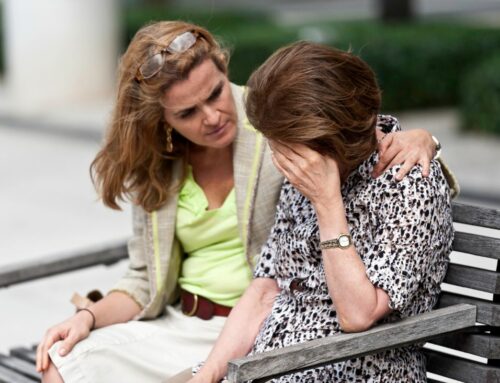About 37 percent of the U.S. workforce will be faced with caring for an older adult in the near future.
Shortly before she celebrated her 80th birthday last month, Sandy renewed her driver’s license. The mother of five, grandmother of 14 and great-grandmother of 9 also hikes, bikes and enjoys walking on the beach.
As an active senior citizen, Sandy is a member of one of America’s fastest-growing population segments. The Federal Interagency Forum on Aging-Related Statistics estimates that by 2018 there will be 40.2 million people in the United States age 65 and older, and 61 million who’re at least 85.
Sandy, like many, wants to remain in her home as long as she possibly can — a concept that’s been termed Aging in Place. She resides in a guest house on the property of her son and daughter-in-law, Jason and Lisa. Dorothy feels secure, yet independent. “I would like to keep it up just as long as I can,” she says of the arrangement.
“It’s a blessing and the timing was perfect,” Lisa adds. “I have two kids who have left home and are in college, with one remaining, so I cook almost every night and my mother-in-law eats with us.”
The guest house was built three years ago for Sandy and her late husband, Frank, who was recovering from cancer surgery and needed to be closer to doctors and family. The guest house includes a bathroom big enough for a wheelchair to turn completely around and safety rails in the shower so Sandy can maintain her independence.
Tough choices for adult children
Baby boomers today, often referred to as the “sandwich generation” because they care for their own children and aging parents, too, is now facing a host of questions: How do I know when mom and dad need help? What types of elder care are available? How will I pay for their elder care? What are my legal rights?
For some baby boomers, it’s hard to admit that the parents who took care of them for years now need tending to themselves. But when an elderly parent begins to struggle with daily activities, it may be time to seek help.
Physical symptoms such as having difficulty walking are significant, as are memory and attention problems, depression and social withdrawal. Changes in eating habits and inability to manage medication and finances are also warning signs.
Elderly parents may become frightened and stubborn, fearing they will be “put away” as their health deteriorates. Times are changing, though, and seniors rarely go straight to a nursing home — if they go at all.
“We now know we made the right move”
Stephanie of Lakeland recently experienced this scenario with her mother, Samantha, 94. “I want her to keep her independence as long as possible but old age is catching up with her,” Benefiel says, “Her short-term memory is not good. One of my biggest fears is that she’ll leave the stove on and forget about it.”
When Stephanie suggested her mother move to an assisted living facility, she was met with resistance. “I’m perfectly fine,” Samanthe said. “Why do you want to put me away?”
Once they assisted living facilities together and Samantha saw they were different from nursing homes, Samantha says she made the transition, moving into a local facility to remain close to family.
“I cannot tell you what a relief it is to have her in a place that is safe, clean and wonderfully accommodating,” Stephanie says. “We now know that we made the right move for her even though we had to be persistent.”
Stephanie runs her own business and she and her husband, Larry, have one son.
“I can’t be driving over there every time [mom] forgets to hang up the telephone receiver all the way or when something comes in the mail that she thinks needs attention in the next five minutes,” she says. “You don’t realize how difficult this is until you start through it.”
Help for caregivers
AARP — formerly known as the American Association of Retired Persons but now accepting members age 50 and over — claims there are 34 million Americans currently serving as unpaid caregivers for family members, spending about 21 hours a week with the relative. AARP estimates the value of that care to be $398 billion in 2017.
“But the unpaid services they provide are not without costs,” says AARP. As caregivers take time off work, the result is lower wages and loss of benefits such as health insurance, retirement savings and Social Security. “Lost time at work and reduced benefits adds to the emotional and physical strain of actually caring for a loved one.”
Available options for elder care
Depending on need, several types of care are available:
- Independent living facilities are for seniors who don’t need special care and more opportunities to socialize. Some also offer meals and transportation.
- In-home services, such as Compassionate Home Care Partners of Polk County, consist of help at home with health care as well as meals and transportation.
- Assisted living facilities allow the senior to live independently, but provide help managing medications and grooming.
- Continuing care is a combination of the above situations; good for a senior whose circumstances may be changing.
- Nursing homes are for those requiring constant care by licensed health care professionals.
- Acute Alzheimer’s care units are generally located within nursing homes with specially-trained staff to treat the disease.
- Adult day care programs provide supervision and activities during daytime hours to give the caregiver a break.
Finding financial relief
Medicare and Medicaid can provide some relief to the cost of elder family member care. Established by the federal government in 1965, Medicare was designed to provide basic health insurance for people 65 and older.
“This program has not only moved most of the aging population into health insurance, it has also removed a huge financial burden from their families,” says the Center for Medicare Advocacy.
Medicare covers hospital, hospice, a short stay in a nursing home (up to 100 days) and some home health services, but does not cover long-term care or even adult day care.
Medicaid is only for people with very limited assets and income. Some seniors are forced to spend their own assets in order to qualify for assistance. Medicaid covers nursing-home care, but not other types of long-term care.






